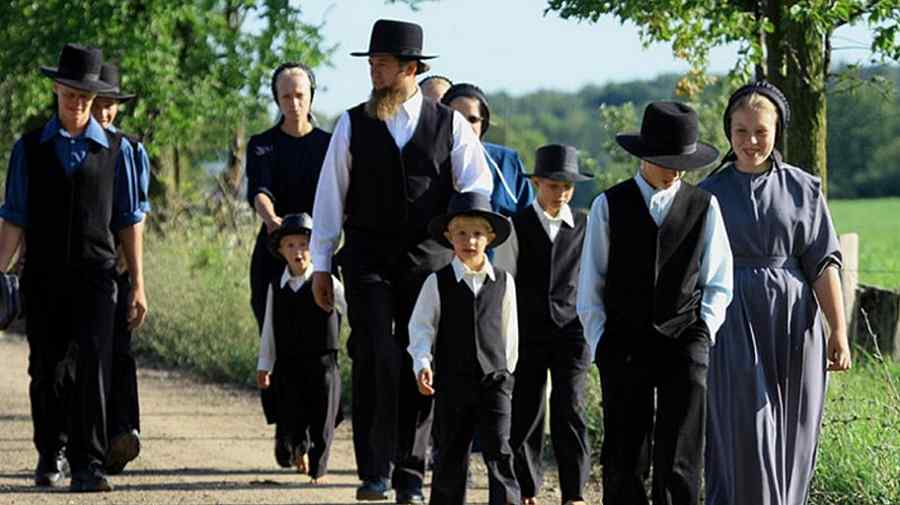Wed 21 June 2023:
The Amish are a religious and Protestant group that inhabits certain areas of the United States and Canada, and it is well known that the most strict do not use electricity or cars because they farm with hand tools and travel on horseback.
History
The Amish have been in America for a long time. The first ones arrived in the early 18th century to escape religious persecution in Europe and to find land to farm. The sect arose from a late-17th century schism in the Anabaptist church by followers of Jakob Amman, a Swiss minister who believed that adherents should “conform to the teachings of Christ and His apostles” and “forsake the world” in their daily lives. The word “Amish” derives from his name.

An Amish woman walks with a child in a wagon past the cornfields of Burton Township, Ohio, the state with the largest Amish population in the U.S. Amy Sancetta, AP
Language
The Pennsylvania Dutch are not Dutch at all. The word Dutch is a corruption of “Deutsch” or German, of which they speak an ancient dialect. Because of its isolation, the language has a very different pronunciation than current German and has been influenced by the English of surrounding populations. Some Amish, notably in Indiana, speak a version closer to Swiss-German.
Growth
The Amish are one of the fastest-growing population groups in America. According to the Young Center for Anabaptist and Pietist Studies at Elizabethtown College in Lancaster, Pa., their population has risen from about 5,000 in 1920 to almost 300,000 today. And much of that growth has occurred in the last three decades. The center estimates there were just 84,000 Amish in 1984, meaning the population has more than tripled during that time. The population explosion is due to a belief in large families, seen as a blessing from God. The large number of children also provide labor for their farming enterprises.

Amish workers raise a new barn near Tollesboro, Ky. Many Amish work in construction and manufacturing, with farming becoming a smaller part of their employment. Terry Prathe, AP
Dating
Perhaps the most famous aspect of Amish social life is “Rumspringa,” which means “running around” in the Pennsylvania German dialect. According to the Young Center, it is the time, beginning at about age 16, when youth socialize with their friends on weekends. Rumspringa ends with marriage. Apart from introducing young men and women to one another, this period is an important time when Amish youth need to decide if they will be baptized and join the church, which usually occurs between 18 and 21, or leave the Amish community.

A horse-drawn cart in Morris passes women wearing traditional white bonnets. Photograph: Dan Callister.
Reject technology
Amish life is governed by the “Ordnung,” a German word for order. The rules vary from community to community. According to the Young Center, “Most Amish groups forbid owning automobiles, tapping electricity from public utility lines, using self-propelled farm machinery, owning a television, radio, and computer, attending high school and college, joining the military, and initiating divorce.” Photos are banned because they might cultivate personal vanity, which runs against the church’s prohibition of “hochmut,” a word meaning pride, arrogance and/or haughtiness.
These communities are associated with a simple lifestyle, reject technology out of respect for tradition and are really slow to adopt new things – considering that in contemporary society, our default is to say ‘yes’ to new things, and in Old Order Amish societies, the default is ‘no’-.

We could say that living without electricity wipes out most of modern society because no electricity means no internet, no TV, and no phones, which makes Amish life in stark contrast to our complex technological lives.
According to the Young Center, the Amish do not consider technology evil in itself, but believe that it has the potential to bring about assimilation into the surrounding society. “Mass media technology in particular, they fear, would introduce foreign values into their culture,” says an article on the Young Center’s website.
‘Rude to use phone’
As we mentioned at the beginning, the Amish reject almost all technology because they only use it when it is necessary, in addition, Wired affirms that it is “rude” to use a mobile phone.
On the other hand, Kevin Kelly pointed out in an article that the objective of the Amish is not to remain in the 17th century by not incorporating technological advances on a day-to-day basis, because they want to strengthen and preserve the traditions of the community.
And so, in case you didn’t know, during the first third of the 20th century, many Amish communities rejected electricity, telephones and radio for exactly the same thing: to make the tradition of the members separate from the rest of the societies.

Why is that they reject technology?
Youssef Khaoulani Menjour (technical support at Microserver Group) points out that “the Amish do not reject technology or the modern world itself, they only reject ‘mundane technologies’ that do not serve to do productive work for the community.”
Aversion aside, these people use “electricity and even temporarily install modern machinery for vital needs.” In addition, they use dairies with refrigerators, farms with computer-controlled technology, and electrical appliances with compressed air to replace batteries.

On the other hand, those objects that became obsolete were credit cards and mobile phones. The first product mentioned, despite the fact that it was used a lot, ended up being rejected when they saw that it generated problems with expenses and indebtedness.
Meanwhile, communities used to have community phones in isolated booths to make calls, but if we delve into today’s cell phones, these devices are a case apart because they do not respect tradition – for this reason they are not introduced into Amish society.
SOURCE: INDEPENDENT PRESS AND NEWS AGENCIES
______________________________________________________________
FOLLOW INDEPENDENT PRESS:
TWITTER (CLICK HERE)
https://twitter.com/IpIndependent
FACEBOOK (CLICK HERE)
https://web.facebook.com/ipindependent
Think your friends would be interested? Share this story!





